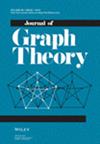Threshold for stability of weak saturation
IF 0.9
3区 数学
Q2 MATHEMATICS
引用次数: 0
Abstract
We study the weak -saturation number of the Erdős–Rényi random graph , denoted by , where is the complete graph on vertices. In 2017, Korándi and Sudakov proved that the weak -saturation number of is stable, in the sense that it remains the same after removing edges with constant probability. In this paper, we prove that there exists a threshold for this stability property and give upper and lower bounds on the threshold. This generalizes the result of Korándi and Sudakov. A general upper bound on is also provided.
弱饱和稳定性阈值
我们研究厄尔多斯-雷尼随机图的弱饱和数,用 ,表示,其中是顶点上的完整图。2017 年,Korándi 和 Sudakov 证明了的弱饱和数是稳定的,即在以恒定概率移除边后,它保持不变。在本文中,我们证明了这一稳定性存在一个阈值,并给出了阈值的上界和下界。这推广了 Korándi 和 Sudakov 的结果。本文还给出了一般的上界。
本文章由计算机程序翻译,如有差异,请以英文原文为准。
求助全文
约1分钟内获得全文
求助全文
来源期刊

Journal of Graph Theory
数学-数学
CiteScore
1.60
自引率
22.20%
发文量
130
审稿时长
6-12 weeks
期刊介绍:
The Journal of Graph Theory is devoted to a variety of topics in graph theory, such as structural results about graphs, graph algorithms with theoretical emphasis, and discrete optimization on graphs. The scope of the journal also includes related areas in combinatorics and the interaction of graph theory with other mathematical sciences.
A subscription to the Journal of Graph Theory includes a subscription to the Journal of Combinatorial Designs .
 求助内容:
求助内容: 应助结果提醒方式:
应助结果提醒方式:


